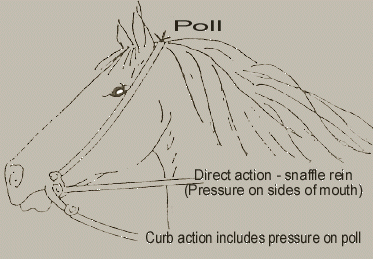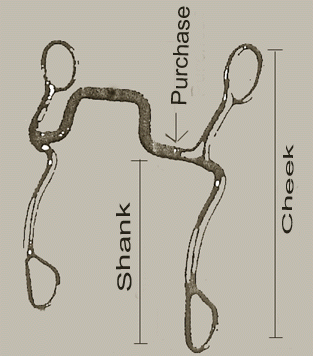

1. Purchase: The part of the bit above the mouthpiece. With
a short purchase, the bit will act quicker in a horse
mouth when the rider pulls on the reins. With a long
purchase, the bit is slower to react.
2. Shank: The part of the bit below the mouthpiece. Will give
the rider leverage on the mouthpiece. The shorter
the shank, the less control - the larger the shank,
the more control.
3. Cheeks: Sides of the bit. Includes both purchase and shank.
4. Mouthpiece: The part of the bit that goes in the horse's mouth.
Types of Mouthpieces:
A. Snaffle: broken in the middle and one of the
most common mouthpieces.
B. Three-piece Snaffle: Broken in two places so
as to work on different places on the bars than
a regular snaffle.
C. Double twisted wire snaffle: Made up of 2 small
snaffles which are broken off-center from each
other.
D. Chain mouthpiece: does not work on the bars
as a snaffle, but on the corners of the mouth.
E. Solid mouthpiece: any mouthpiece that is not
broken.
i. Bars - rest on the horse's bars (gums behind teeth).
ii. Port - rest of the tongue
There are high, medium and low
port bits. The closer the bars
are together the more severe. The
wider apart, the less severe.
iii. Mullen Relief - a forward curve to the
mouthpiece gives even pressure across
the mouth. This causes a smoother
reaction from the horse.
F. Swivel mouthpiece: the mouthpiece swivels on
the shank.
i. Allows independent shank action
ii. Gives the mouthpiece a different action
than a solid constructed bit.
5. Curb Bit: Rotation in mouth down on mouth, up on curb chain,
pressure on poll.
6. Curb Chain Pressure: Varies from one bit to another.
Sets timing of the bit.
Loose Curb Chain = slower timing
Tight Curb Chain = faster timing
7. Metals Used in Mouthpieces
A. Copper - causes a horse's mouth to salivate which
allows the mouth to stay soft and usable to the rider.
B. Sweet Iron - It is intended to rust. It actually does
have a sweet taste to it as rusting occurs.
C. Stainless Steel - gives a clean, neat look to any
mouthpiece.
8. The "feel of the bit": Not only what the horse feels when the rider
puts pressure on the reins, but also what the
rider feels, for example - suppleness or stiffness.
9. Timing: The amount of time required from the point when
the reins are pulled until the bit has done as
much as it can do.
Bits & Bridles Terminology
The bit, attached to the bridle, is used to communicate to the horse. There are several areas on the horse's head where pressure is exerted, asking the horse for a response. These areas include the bars of the mouth, lips, tongue, hard palate, chin, nose and poll. The tongue and hard palate being the most sensitive.

Web Site Design by S&J Enterprises - Homestead Website Design

